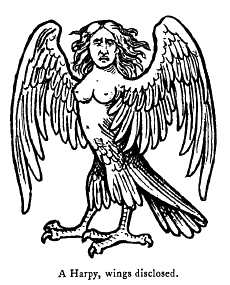
In Greek mythology, the Trojan War was waged against the city of Troy by the Achaeans (Greeks) after Paris of Troy took Helen from her husband Menelaus, king of Sparta. The war is one of the most important events in Greek mythology and has been narrated through many works of Greek literature, most notably Homer's Iliad. The core of the Iliad describes a period of four days and two nights in the tenth year of the decade-long siege of Troy; the Odyssey describes the journey home of Odysseus, one of the war's heroes. Other parts of the war are described in a cycle of epic poems, which have survived through fragments. Episodes from the war provided material for Greek tragedy and other works of Greek literature, and for Roman poets including Virgil and Ovid.

In Greek mythology and Roman mythology, a harpy is a half-human and half-bird personification of storm winds. They feature in Homeric poems.
In Greek mythology, Atë, Até or Aite was the goddess of mischief, delusion, ruin, and blind folly, rash action and reckless impulse who led men down the path of ruin. She also led both gods and men to rash and inconsiderate actions and to suffering. Até also refers to an action performed by a hero that leads to their death or downfall.
Enyo is a goddess of war in Greek mythology. She frequently is associated with the war god Ares.

In Greek mythology the Horae or Horai or Hours were the goddesses of the seasons and the natural portions of time.

In Greek mythology, Machaon was a son of Asclepius; and the older brother of Podalirius. He and his brother led an army from Tricca in the Trojan War on the side of the Greeks.
Quintus Smyrnaeus was a Greek epic poet whose Posthomerica, following "after Homer" continues the narration of the Trojan War. The dates of Quintus Smyrnaeus' life and poetry are disputed: by tradition, he is thought to have lived in the latter part of the 4th century AD, but early dates have also been proposed.
The name Eurymachus is attributed to the following individuals:

The Posthomerica is an epic poem in Greek hexameter verse by Quintus of Smyrna. Probably written in the latter half of the 4th century AD, it tells the story of the Trojan War, between the death of Hector and the fall of Ilium.

In Greek mythology, Meriones was a son of Molus and Melphis or Euippe. Molus was a half-brother of Idomeneus. Like other heroes of mythology, Meriones was said to be a descendant of gods. As a grandson of Deucalion, Meriones's ancestors include Zeus, Europa, Helios, and Pasiphae, the sister of Circe. Meriones possessed the helmet of Amyntor, which Autolycus had stolen. He inherited the helmet from his father Molus and later gave it to Odysseus. Meriones killed seven men at Troy.
In Greek mythology, Kydoimos or Cydoemus was the personification of the din of battle, confusion, uproar and hubbub. He was probably numbered amongst the Makhai, daimones of the battlefield. Kydoimos appears in Aristophanes' Peace as a character.
Prayer features prominently in the works of Homer. In the Iliad and the Odyssey, gods are portrayed as coexisting and often interfering with the world of the human characters, who often communicate with the gods through prayer. Gods usually hear, often react to and sometimes grant human prayers.
In Greek mythology, the Hysminae or Hysminai are the personifications of fighting.
In Greek mythology, Agastrophus is a Paionian "hero", "famed for his spear", fighting on the side of Troy in the Trojan War, killed by Diomedes. He was the son of Paeon and brother of Laophoon.

In Greek mythology, Eurypylus ("Broadgate") was the son of Telephus, king of Mysia. He was a great warrior, who led a Mysian contingent that fought alongside the Trojans against the Greeks in the Trojan War. He killed Machaon, and was himself killed by Achilles' son Neoptolemus.
In Greek mythology, Paean, Paeëon or Paieon, or Paeon or Paion may refer to the following characters:
In Greek mythology, Peisander or Pisander may refer to the following characters:
In Greek mythology, Cymothoë was the 'cerulean' Nereid of gentle and quiet waves. She was a marine-nymph daughter of the 'Old Man of the Sea' Nereus and the Oceanid Doris.
In Greek mythology, Eëtion may refer to the following personages:
In Greek mythology, Tisiphone was the Trojan daughter of Antimachus and sister of Hippolochus, Pisander, and Hippomachus. She was the wife of Meneptolemus.
 This article incorporates text from this source, which is in the public domain .
This article incorporates text from this source, which is in the public domain . This article incorporates text from this source, which is in the public domain .
This article incorporates text from this source, which is in the public domain .




